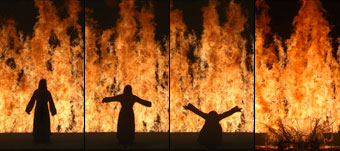2008Bill Viola Fire Woman Download education notes (PDF 9pp) Requires Adobe Acrobat Reader. Visit the Adobe website to download a free copy. I don’t like the label ‘video artist.’ I consider myself to be an artist. I happen to use video because I live in the last part of the 20th century. Bill Viola, Reasons for knocking at an empty house, MIT Press/Anthony d’Offay Gallery, Cambridge Mass/London 1995 What marks out Viola from other video art luminaries like Nam June Paik and Bruce Nauman is his interest in filling the emergent medium of video with subversive ethnographic discourses – Gnostic belief systems, Eastern spiritual disciplines, Renaissance memory protocols, shamanic trance practices… Steve Beard, Aftershocks: the end of style culture, Wallflower Press, London 2002 |  At the invitation of John Kaldor, Bill Viola presented two works from his 2005 series The Tristan Project in the darkened space of St Saviour’s Church in Redfern, Sydney, in April and May 2008. Viola’s installation amalgamated the shadowy architectural setting with a six-metre, high-definition colour projection screen, five-channel sound and an enveloping operatic narrative. Viola has used these sacred settings in the past to make some of the finest church art of our time, including The Messenger, which was first shown in Durham Cathedral in England (and later, in 1999, at the Art Gallery of NSW), and Ocean Without a Shore, which used the three stone altars of the 15th-century Church of San Gallo during the Venice Biennale. The Tristan Project was begun in late 2004 as an evolving backdrop to a production of Richard Wagner’s Tristan und Isolde by the Los Angeles Philharmonic, directed by Peter Sellars. It was presented in project form in Los Angeles in 2004 and the complete opera premiered at the Opéra National de Paris in France in 2005. The two pieces presented in Viola’s Kaldor project – Fire Woman 2005 and Tristan’s Ascension (The Sound of a Mountain Under a Waterfall) 2005 – were part of the sequence at a climactic section late in Wagner’s narrative. In Fire Woman, a female figure is silhouetted against a wall of flame. After some moments, she moves forward, opening her arms, and then she falls into her own reflection. Tristan’s Ascension is the ascent of the spirit in the time after death as it is re-awakened and uncannily drawn up in a backwards-flowing waterfall. The references for these images extend well beyond Wagner. Dealing with the ultimates of human experience – the kind of metaphysical territory and emotional range that we find in TS Eliot’s poem Four quartets – Viola also brings to mind the Tibetan Bardo states of passage through death to another stage through a kind of waterfall. At the same time as the Fire Woman and Tristan’s Ascension were presented as a Kaldor project at St Saviour's, the Art Gallery of NSW showed another work from The Tristan Project. The Fall into Paradise 2005 begins with a tiny speck of light in a black field which gradually resolves into the entwined bodies of two figures. Slowly they drift upwards until they break the surface to float suspended as silhouettes on a luminous blue field. Read more about Bill Viola. Bill Viola’s Fire Woman 2005, part of the series The Tristan Project, which was installed in St Saviour’s Church in Sydney in 2008. Video/sound installation: color high-definition video projection; four channels of sound with subwoofer (4.1); screen size 580 x 326 cm (19 x 10.7 ft); room dimensions variable. Photo: Kira Perov © Bill Viola | WORLD EVENTSWorld stockmarkets plunge, fuelled by the US subprime mortgage crisis Activists in Egypt use Facebook to rally for democracy Rising food and fuel prices trigger riots in the Third World Release of WALL-E, Pixar’s ecologically-minded animation Australian Prime Minister Kevin Rudd delivers a formal apology to the Stolen Generations MySpace Australia holds its first art competition Artists resale royalty right scheme introduced in Australia Police in Sydney confiscate artist Bill Henson’s photographs, sparking debate on censorship Biennale of Sydney, Revolutions – forms that turn, artistic director Carolyn Christov-Bakargiev Gift of the John Kaldor Family Collection to the Art Gallery of NSW announced 17th Kaldor project Two works – Fire Woman and Tristan’s Ascension (The Sound of a Mountain Under a Waterfall) – from Bill Viola’s The Tristan Project installed at St Saviour’s Church in the Sydney suburb of Redfern 18th Kaldor project Martin Boyce creates the installation We are shipwrecked and landlocked in the grounds of Old Melbourne Gaol | ||